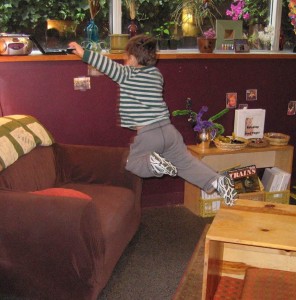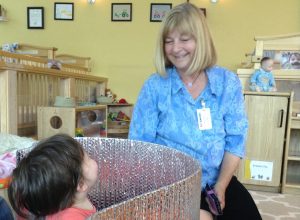
Toddlers and Trust Falls: Active Play
[et_pb_section bb_built=”1″ admin_label=”section”][et_pb_row admin_label=”row”][et_pb_column type=”4_4″][et_pb_text admin_label=”Text” background_layout=”light” text_orientation=”left” use_border_color=”off” border_color=”#ffffff” border_style=”solid”]
Why do children need to use their bodies – both indoors and outdoors – in strong and active ways? It’s more than just “getting their wiggles out” so they can participate cooperatively in the less active parts of their days. Children deserve access to active – even risky – play, in order to help their brains develop.
According to the Child Development Institute, as cited in this article, “physical play helps a child to develop connections between the nerve cells and the brain. As these connections develop, a child’s fine and gross motor skills, socialization, personal awareness, language, creativity and problem solving are improved. Ideal physical play incorporates play with social interactions and problem solving.”
In her article What’s the Risk of No Risk educator and author Deb Curtis reminds us that “children deserve and benefit from challenges and adventures that include risk. Their self-esteem grows, along with their physical and mental abilities as they negotiate risks appropriate for their personality and development.”
Here’s a story from one of Hilltop’s toddler educators, Bria Bloom, about some risky, physical, active play she facilitated with a group two- and three-year-olds in her classroom:
[/et_pb_text][/et_pb_column][/et_pb_row][/et_pb_section][et_pb_section bb_built=”1″ admin_label=”Section” fullwidth=”off” specialty=”off”][et_pb_row admin_label=”Row”][et_pb_column type=”1_4″][et_pb_image admin_label=”Image” src=”https://hilltopcc.com/wp-content/uploads/2017/04/trust-falls-3-e1493140178886.png” show_in_lightbox=”off” url_new_window=”off” use_overlay=”off” animation=”off” sticky=”off” align=”left” force_fullwidth=”off” always_center_on_mobile=”on” use_border_color=”off” border_color=”#ffffff” border_style=”solid” /][et_pb_image admin_label=”Image” src=”https://hilltopcc.com/wp-content/uploads/2017/04/trust-falls-2-e1493140219518.jpg” show_in_lightbox=”off” url_new_window=”off” use_overlay=”off” animation=”off” sticky=”off” align=”left” force_fullwidth=”off” always_center_on_mobile=”on” use_border_color=”off” border_color=”#ffffff” border_style=”solid” /][et_pb_image admin_label=”Image” src=”https://hilltopcc.com/wp-content/uploads/2017/05/rsz_1rsz_1rsz_falls1.jpg” show_in_lightbox=”off” url_new_window=”off” use_overlay=”off” animation=”off” sticky=”off” align=”left” force_fullwidth=”off” always_center_on_mobile=”on” use_border_color=”off” border_color=”#ffffff” border_style=”solid” /][et_pb_image admin_label=”Image” src=”https://hilltopcc.com/wp-content/uploads/2017/04/trust-falls-1-e1493140257193.jpg” show_in_lightbox=”off” url_new_window=”off” use_overlay=”off” animation=”off” sticky=”off” align=”left” force_fullwidth=”off” always_center_on_mobile=”on” use_border_color=”off” border_color=”#ffffff” border_style=”solid” /][/et_pb_column][et_pb_column type=”3_4″][et_pb_text admin_label=”Text” background_layout=”light” text_orientation=”left” use_border_color=”off” border_color=”#ffffff” border_style=”solid”]
Trust falls are tricky. You have to trust the person behind you to catch you no matter what. Since these children had not done trust falls before, and it can be difficult for kids to support one another’s weight – especially as someone falls backward into their arms – we did a modified version of trust falls that involved sitting down and catching instead of standing up.
First, I had all the children do trust falls with me catching them. I then gave them the option of catching each other, and that was met with an enthusiastic, “Yes!” They tested out forward falls and backward falls.
Alice caught kids first. She sat down on the pillow and got ready. David lowered himself backwards and fell into Alice’s lap.
Alice: Aaaahh!
Bria: You got him.
Zane: I’m really strong.
Alice caught every child once, then it was another kid’s turn.
Bria: Okay, let’s let Serena catch.
Alice did her fall first, landing right in Serena’s lap. David got ready to go next.
David: Hhhhhhhhh… Haha!
David fell into Serena’s lap, and they both laughed.
Zane was up next. He stood there tentatively, and looked backwards at Serena. Serena clapped her hands then stuck her arms out to show him she was ready. Zane fell back into her lap, and they both smiled. David then took a turn catching, and Alice chose to fall forward instead of backwards. David caught each child in turn, and then it was Zane’s turn to fall. This time Zane was much less tentative, and fell right back into David’s arms. It was then Zane’s turn to catch. He caught Alice’s front fall first, then David took a slow fall, then Serena, a faster fall.
[/et_pb_text][/et_pb_column][/et_pb_row][/et_pb_section][et_pb_section bb_built=”1″ admin_label=”Section” fullwidth=”off” specialty=”off”][et_pb_row admin_label=”Row”][et_pb_column type=”4_4″][et_pb_text admin_label=”Text” background_layout=”light” text_orientation=”left” use_border_color=”off” border_color=”#ffffff” border_style=”solid”]
Deb Curtis goes on to say that “learning involves risk. Relationships involve risk. Feeling competent and confident in the world requires meeting a challenge and working to overcome it. When children are involved in a situation we think is too risky or dangerous, rather than just stopping them we can offer alternatives that keep them safe while preserving opportunities for them to develop to their fullest potential. We can support them in learning that determination pays off, and they can become competent decision makers, able to assess risks, contribute to the well-being of others, and reap the rewards of their efforts.”
 Please join us on Thursday, June 1st for an evening with Deb Curtis, where she’ll be discussing the Importance of the Active Body Brain Connection. This discussion will invite you to study principles that can help ensure children get the active play experiences they deserve. Deb Curtis, is the co-founder of Harvest Resources, and distinguished author of several books including “Learning Together with Young Children: A Curriculum Framework for Reflective Teachers” comes with over 40 years of experience working with children and teachers, observing and studying children and child development. For more information on this event visit us at www.hilltopcc.com/active
Please join us on Thursday, June 1st for an evening with Deb Curtis, where she’ll be discussing the Importance of the Active Body Brain Connection. This discussion will invite you to study principles that can help ensure children get the active play experiences they deserve. Deb Curtis, is the co-founder of Harvest Resources, and distinguished author of several books including “Learning Together with Young Children: A Curriculum Framework for Reflective Teachers” comes with over 40 years of experience working with children and teachers, observing and studying children and child development. For more information on this event visit us at www.hilltopcc.com/active
[/et_pb_text][et_pb_text admin_label=”Text” background_layout=”light” text_orientation=”left” use_border_color=”off” border_color=”#ffffff” border_style=”solid”]
Sarah Felstiner is the Curriculum Director at Hilltop Children’s Center, where she has worked since 1995. Recognized as a Master Leader by Exchange Press, Sarah strives to offer the early childhood field compelling and accessible models for teaching and learning, rooted in strong values and built upon infrastructures that support reflective practice for both children and adults. When she’s not at Hilltop, Sarah can often be found playing the flute or guitar, or following the Iditarod Sled Dog races!
[/et_pb_text][et_pb_comments admin_label=”Comments” show_avatar=”on” show_reply=”on” show_count=”on” background_layout=”light” use_border_color=”off” border_color=”#ffffff” border_style=”solid” custom_button=”off” button_letter_spacing=”0″ button_use_icon=”default” button_icon_placement=”right” button_on_hover=”on” button_letter_spacing_hover=”0″ /][/et_pb_column][/et_pb_row][/et_pb_section]
